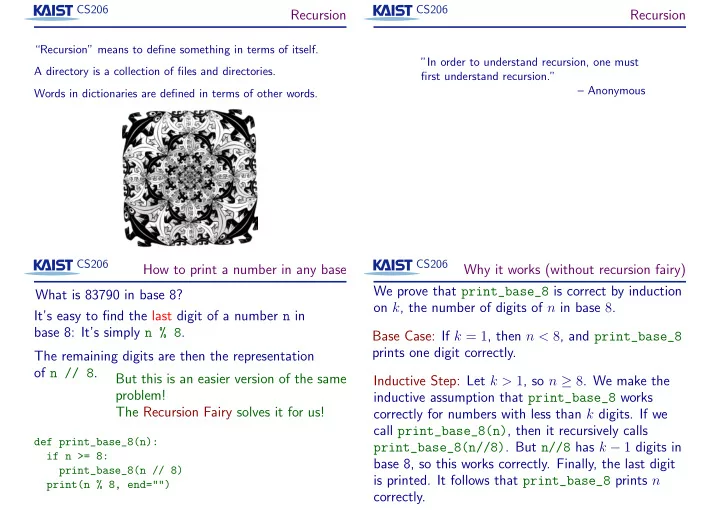

CS206 CS206 Recursion Recursion “Recursion” means to define something in terms of itself. ”In order to understand recursion, one must A directory is a collection of files and directories. first understand recursion.” – Anonymous Words in dictionaries are defined in terms of other words. CS206 CS206 How to print a number in any base Why it works (without recursion fairy) We prove that print_base_8 is correct by induction What is 83790 in base 8? on k , the number of digits of n in base 8 . It’s easy to find the last digit of a number n in base 8: It’s simply n % 8 . Base Case: If k = 1 , then n < 8 , and print_base_8 prints one digit correctly. The remaining digits are then the representation of n // 8 . But this is an easier version of the same Inductive Step: Let k > 1 , so n ≥ 8 . We make the problem! inductive assumption that print_base_8 works The Recursion Fairy solves it for us! correctly for numbers with less than k digits. If we call print_base_8(n) , then it recursively calls def print_base_8(n): print_base_8(n//8) . But n//8 has k − 1 digits in if n >= 8: base 8, so this works correctly. Finally, the last digit print_base_8(n // 8) is printed. It follows that print_base_8 prints n print(n % 8, end="") correctly.
CS206 CS206 For arbitrary base The Recursion Fairy DIGITS = "0123456789abcdef" We solve problems by splitting them into simpler subproblems. Then we can hand off each subproblem to a helper. MAX_BASE = len(DIGITS) Recursion happens when the subproblem is exactly the same as # Precondition: n >= 0, 2 <= base <= 16 the original problem, only smaller (or in some way “easier.”) def print_rec(n, base): We can still imagine handing off the subproblem to a if n >= base: helper—the Recursion Fairy. She will “magically” solve the print_rec(n // base, base) subproblem for us. How she does this is none of our business. digit = n % base Our task is only to simplify the problem into smaller print(digits[digit], end="") subproblems, or to solve it directly when simplification is not possible or not necessary. CS206 CS206 Factorial Mistakes Why doesn’t this work? Factorial: n ! is n × ( n − 1)! . def factorial(n): return n * factorial(n - 1) # Compute n! And this one? def factorial(n): if n <= 1: def factorial(n): return 1 if n <= 1: else: return 1 return n * factorial(n-1) else: return n * factorial(n) }
CS206 CS206 Correctness of recursive methods Recursive drawings Ruler The Recursion Fairy takes care of the simpler subproblems. There has to be a base case. And we need to be sure that we will reach the base case eventually—there has to be some progress in Fractal star H-tree each recursive call. In other words, the version given to the Recursion Fairy has to be easier than the original problem. Do you know the formal name of the recursion fairy? She is the induction hypothesis in mathematical induction. CS206 CS206 A recursive definition: trees Too much recursion The Fibonacci numbers F 0 , F 1 , F 2 , . . . are defined as follows: A tree consists of a root and zero or more subtrees, F 0 = 0 , F 1 = 1 , and F i = F i − 1 + F i − 2 for i > 1 . each of whose roots are connected to the root. def fib(n): if n == 0: root return 0 elif n == 1: return 1 else: return fib(n - 1) + fib(n - 2) Recursion is not useful when recursive calls duplicate work. Each edge goes from the parent to the child. Don’t solve the same subproblem in separate recursive calls.
CS206 CS206 Towers of Hanoi Indirect recursion Three poles, n discs. All the previous examples are examples of direct recursion: A function calls itself. One move: take the top disc from one pole and move it to another pole. Indirect recursion happens when there are two (or more) Goal: Move all discs from pole A to pole B. functions f and g , such that f calls g and g calls f . If you want to understand indirect recursion in more detail, please see the next slide. A B C CS206 Indirect recursion For an explanation of indirect recursion, please see the previous slide. Sine and cosine can be computed using the following identities: sin x = 2 sin x 2 cos x 2 cos x = 1 − 2(sin x 2 ) 2 Your computer uses indirectly recursive methods sin(x) and cos(x) that compute sin x and cos x using these identities. The base case occurs when x is so small that a direct approximation is possible.
Recommend
More recommend